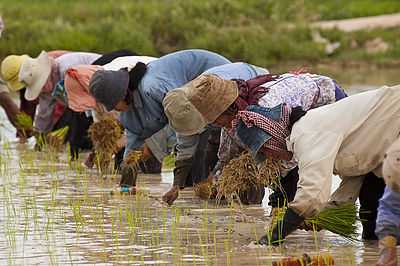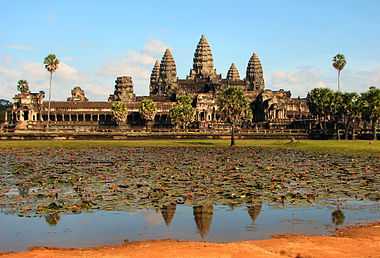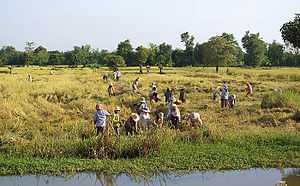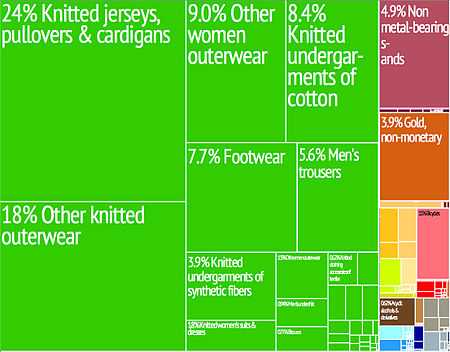Economy of Cambodia
| Economy of Cambodia | |
|---|---|
|
Aerial view of Phnom Penh | |
| Currency | Riel |
| Calendar year | |
Trade organisations | WTO, ASEAN, AFTA |
| Statistics | |
| GDP |
PPP $36.590 billion (2012) Nominal~ $14.250 billion (2012) |
| GDP rank | 117th (nominal) / 104th (PPP) |
GDP growth | 7.3% (2012) |
GDP per capita |
PPP $2,490 (2012) Nominal~ $1,150 (2012) |
GDP by sector |
agriculture: 34.7% industry: 24.3% services: 41.0% (2012 est.) |
| 4.1% | |
Population below poverty line | 18.6% (2012) |
Labour force | 8.8 million (2010) |
Labour force by occupation |
agriculture: 57.6% industry: 15.9% services: 26.5% (2010) |
| Unemployment | 3.5% |
Main industries |
List
|
| 138th[1] | |
| External | |
| Exports | $8.433 billion (2012) |
Export goods | clothing, timber, rubber, rice, fish, tobacco, footwear |
Main export partners |
|
| Imports | $8.840 billion (2012) |
Import goods | petroleum products, cigarettes, gold, construction materials, machinery, motor vehicles, pharmaceutical products |
Main import partners |
|
Gross external debt | $5.071 billion (2012) |
| Public finances | |
| Revenues | $2.216 billion (2012) |
| Expenses | $2.934 billion (2012) |
| Economic aid | $934 million pledged in grants and concessional loans for 2011 by international donors |
|
B+ (Domestic) B+ (Foreign) BB- (T&C Assessment) (Standard & Poor's)[4] | |
Foreign reserves | US$3.84 billion (2010) |
|
All values, unless otherwise stated, are in US dollars. | |
The economy of Cambodia at present follows an open market system (market economy) and has seen rapid economic progress in the last decade.[5] Cambodia had a GDP of $13 billion in 2012.[6] Per capita income, although rapidly increasing, is low compared with most neighboring countries. Cambodia's two largest industries are textiles and tourism, while agricultural activities remain the main source of income for many Cambodians living in rural areas.[7] The service sector is heavily concentrated on trading activities and catering-related services. Recently, Cambodia has reported that oil and natural gas reserves have been found off-shore.[8]
In 1995, the government transformed the country's economic system from a planned economy to its present market-driven system.[9] Following those changes, growth was estimated at a value of 7% while inflation dropped from 26% in 1994 to only 6% in 1995. Imports increased due to the influx of foreign aid, and exports, particularly from the country's garment industry, also increased.
After four years of improving economic performance, Cambodia's economy slowed in 1997-98 due to the regional economic crisis, civil unrest, and political infighting. Foreign investments declined during this period. Also, in 1998 the main harvest was hit by drought. But in 1999, the first full year of relative peace in 30 years, progress was made on economic reforms and growth resumed at 4%.
Currently, Cambodia's foreign policy focuses on establishing friendly borders with its neighbors (such as Thailand and Vietnam), as well as integrating itself into regional (ASEAN) and global (WTO) trading systems. Some of the obstacles faced by this emerging economy are the need for a better education system and the lack of a skilled workforce; particularly in the poverty-ridden countryside, which struggles with inadequate basic infrastructure. Nonetheless, Cambodia continues to attract investors because of its low wages, plentiful labor, proximity to Asian raw materials, and favorable tax treatment.[10]
Recent economic history
Following its independence from France in 1953, the Cambodian state has undergone five periods of political, social, and economic transformation:
- Kingdom of Cambodia (1953-1970)
- Khmer Republic (1970–1975)
- Democratic Kampuchea (1975-1979)
- People's Republic of Kampuchea (1979-1989), later renamed The State of Cambodia (1989 to 1993)
- Kingdom of Cambodia (1993–present)
In 1989, the State of Cambodia implemented reform policies that transformed the Cambodian economic system from a command economy to an open market one.[11] In line with the economic reformation, private property rights were introduced and state-owned enterprises were privatized. Cambodia also focused on integrating itself into regional and international economic blocs, such as the Association of South East Asian Nations and the World Trade Organization respectively. These policies triggered a growth in the economy, with its national GDP growing at an average of 6.1% before a period of domestic unrest and regional economic instability in 1997 (1997 Asian Financial Crisis).[11] However, conditions improved and since 1999, the Cambodian economy has continued to grow at an average pace of approximately 6-8% per annum.[12]
In 2007, Cambodia's gross domestic product grew by an estimated 18.6%. Garment exports rose by almost 8%, while tourist arrivals increased by nearly 35%. With exports decreasing, the 2007 GDP growth was driven largely by consumption and investment. Foreign direct investment(FDI) inflows reached US$600 million (7 percent of GDP), slightly more than what the country received in official aid. Domestic investment, driven largely by the private sector, accounted for 23.4 percent of GDP. Export growth, especially to the US, began to slow in late 2007 accompanied by stiffer competition from Vietnam and emerging risks (a slowdown in the US economy and lifting of safeguards on China’s exports). US companies were the fifth largest investors in Cambodia, with more than $1.2 billion in investments over the period 1997-2007.
Cambodia was severely hit by the 2008 economic crisis (refer to table below), and its main economic sector, the garment industry, suffered a 23% drop in exports to the United States of America and Europe.[13] As a result, 60,000 workers were laid off. However, in the last quarter of 2009 and early 2010, conditions were beginning to improve and the Cambodian economy began to recover. Cambodian exports to the US for the first 11 months of 2012 reached $2.49 billion, a 1 per cent increase year-on-year. Its imports of US goods grew 26 per cent for that period, reaching $213 million. Another factor underscoring the potential of the Cambodian economy is the recent halving of its poverty rate. The poverty rate is 20.5 per cent, meaning that approximately 2.8 million people live below the poverty line[14]
The table below represents the fluctuations in Cambodia's economy over the period from 2004–2011 (2012 data is not yet available).[15]
| Category | 2004 | 2005 | 2006 | 2007 | 2008 | 2009 | 2010 | 2011 |
|---|---|---|---|---|---|---|---|---|
| GNI per capita, PPP(current international $) | 1,250 | 1,440 | 1,630 | 1,830 | 1,960 | 1,970 | 2,080 | 2,230 |
| Total Population (Millions) | 13.19 | 13.36 | 13.52 | 13.67 | 13.82 | 13.98 | 14.14 | 14.31 |
| GDP (Millions US$) | 5,337.83 | 6,293.05 | 7,274.42 | 8,639.16 | 10,351.83 | 10,401.94 | 11,242.27 | 12,829.54 |
| GDP Growth (annual %) | 10.34 | 13.25 | 10.77 | 10.21 | 6.69 | 0.09 | 5.96 | 7.07 |
Economic sectors
Garment industry
The garment industry represents the largest portion of Cambodia's manufacturing sector, accounting for 80% of the country's exports. In 2012, the exports grew to $4.61 billion up 8% over 2011. In the first half of 2013, the garment industry reported exports worth $1.56 billion.[16] The sector employs 335,400 workers, of which 91% are female.
The sector operates largely on the final phase of garment production, that is turning yarns and fabrics into garments, as the country lacks a strong textile manufacturing base. In 2005, there were fears that the end of the Multi Fibre Arrangement would threaten Cambodia's garment industry; exposing it to stiff competition with China's strong manufacturing capabilities.[17] On the contrary, Cambodia's garment industry at present continues to grow rapidly. This is can be attributed to the country's open economic policy which has drawn in large amounts of foreign investment into this sector of the economy.
Garment Factories by Ownership Nationality in 2010:[18]
| Nationality of Ownership | Ownership by percentage | Number of factories owned |
|---|---|---|
| Taiwan | 28% | 66 |
| China | 19% | 44 |
| Hong Kong | 17% | 39 |
| South Korea | 13% | 31 |
| Malaysia | 6% | 14 |
| Cambodia | 5% | 13 |
| Singapore | 4% | 10 |
| USA | 4% | 9 |
| Others | 4% | 10 |

note: In 2010, 236 garment export-oriented factories were operating and registered with GMAC,
with 93% being foreign direct investment (FDI).
As seen in the table above, Cambodia's garment industry is characterized by a small percentage of local ownership. This is a reflection of the deficiency of skilled workers in the country as well as the limited leverage and autonomy Cambodian factories have in strategic decisions.[19] Another characteristic of the industry is the country's competitive advantage as the only country where garment factories are monitored and reported according to national and international standards.[20]
This has allowed Cambodia to secure its share of quotas for exports to the US through the US-Cambodia Trade Agreement on Textiles and Apparel (1999–2004), which linked market access to labor standards. However, the Cambodian garment industry remains vulnerable to global competition due to a lack of adequate infrastructure, labor unrest, the absence of a domestic textile industry, and almost complete dependence on imported textile material.[21]
Agriculture

Agriculture is the traditional mainstay of the Cambodian economy. Agriculture accounted for 90 percent of GDP in 1985 and employed approximately 80 percent of the work force. Rice is the principle commodity.
Major secondary crops include maize, cassava, sweet potatoes, groundnuts, soybeans, sesame seeds, dry beans, and rubber. The principal commercial crop is rubber. In the 1980s it was an important primary commodity, second only to rice, and one of the country's few sources of foreign exchange.
Tourism
In the 1960s, Cambodia was a prominent tourist destination in the Southeast Asian region. Due to protracted periods of civil war, insurgencies, and especially the genocidal regime of the Khmer Rouge (see Khmer Rouge Genocide), Cambodia's tourism industry was reduced to being virtually non-existent. Since the late 1990s, tourism is fast becoming Cambodia's second largest industry, just behind the garment manufacturing.[22] In 2006, Cambodia's tourism sector generated a revenue of US$1.594 billion, which made up approximately 16% of the country's GDP.[22]

Cultural heritage tourism is especially popular in the country, with many foreign tourists visiting the ancient Hindu temple of Angkor Wat located in the Siem Reap province. Other popular tourist attractions include the Royal Palace, Phnom Penh, as well as ecotourism spots such as Tonlé Sap Lake and the Mekong River.
The tourism industry in Cambodia has been perpetuated by the development of important transportation infrastructure; in particular Cambodia's two international airports in Phnom Penh and Siem Reap respectively. To the Cambodian economy, tourism has been a means for accumulation of foreign currency earnings and employment for the Cambodian workforce, with about 250,000 jobs generated in 2006.[22] Meanwhile, challenges to the industry include a leakage of revenue to foreign markets due to a dependence on foreign goods as well as the prevalence of the Child sex tourism industry.[23]
Gambling industry
The gambling industry of Cambodia supports its tourism industry, which is mostly concentrated around the Siem Reap province. The introduction of casino on border cities and towns created an industry that has thrived and contributed to the generation of employment and a steady stream of revenue for the government. However, the issue of corruption in relation to the government bureaucratic process involved in the gambling sector has been raised. It has likewise spur growth in different parts of the country at border crossing towns like Poipet, Bavet and Koh Kong. The growth of the gambling industry in Cambodia is due to its proximity to Thailand where gambling is forbidden.
Construction
The increase in tourist arrivals has led to growing demand for hotels and other forms of accommodation surrounding tourist hotspots. Siem Reap in particular has seen a construction boom in recent years. The capital Phnom Penh has also witnessed a growth in the construction and real estate sector. Recently, planned projects that have been on the pipeline for several years have been shelved temporarily due to a reduction in foreign investment. From 2009, the Cambodian government has allowed foreigners to own condominiums. This has helped in attracting real estate investors from Thailand, Malaysia, Singapore and other countries.
The construction sector attracted investment of $2.1 billion in 2012 which is a 72 per cent rise compared with 2011. Construction licenses issued stood at 1,694 projects in 2012, which was 20% lower than 2011 but they were higher in value.
Resources
Oil seeps were discovered in Cambodia as early as the 1950s by Russian and Chinese geologists. Development of the industry was delayed, however, by the Vietnam and Cambodian Civil Wars and the political uncertainty that followed. Further discoveries of oil and natural gas deposits offshore in the early 2000s led to renewed domestic and international interest in Cambodia's production possibilities. As of 2013, the US company Chevron, Japanese JOGMEC and other international companies maintained production sites both on shore and off. Chevron alone had invested over 160 million USD and drilled 18 wells.[24]
Sok Khavan, acting director general of the Cambodian National Petroleum Authority, estimated that once the contracts are finalized and legal issues resolved, the Cambodian government will receive approximately 70% of the revenues, contributing to an economy in which the GDP is projected to increase five-fold by 2030.[25] In addition, there are 10,000 square miles offshore in the Gulf of Thailand that holds potential reserves of 12-14 trillion cubic feet of natural gas and an unspecified amount of oil.[25] The rights to this territory are currently a subject of dispute between Cambodia and Thailand, further delaying any possible production developments. In early 2013 it was reported that the two countries were close to a deal that would allow joint production to begin.[26][27]
Foreign aid

Cambodia's emerging democracy has received strong international support. Under the mandate of the United Nations Transitional Authority in Cambodia (UNTAC), $1.72 billion (1.72 G$) was spent in an effort to bring basic security, stability and democratic rule to the country.
With regards to economic assistance, official donors had pledged $880 million at the Ministerial Conference on the Rehabilitation of Cambodia (MCRRC) in Tokyo in June 1992. In addition to that figure, $119 million was pledged in September 1993 at the International Committee on the Reconstruction of Cambodia (ICORC) meeting in Paris, and $643 million at the March 1994 ICORC meeting in Tokyo.
Cambodia experienced a shortfall in foreign aid in the year 2005 due to the government's failure to pass anti-corruption laws, opening up a single import/export window, increasing its spending on education, and complying with policies of good governance.[28] In response, the government adopted the National Strategic Development Plan for 2006–10 (also known as the “Third Five-Year Plan”). The plan focused on three major areas:
- the speeding up of economic growth at an annual rate of 6-7%
- eradicating corruption
- developing public structures in favor of quality (i.e. by education, training, and healthcare) over quantity (i.e. rapid population growth)[29]
Statistics

- Investment (gross fixed)
- 3% of GDP (2011 est.)
- Household income or consumption by percentage share
- lowest 10%: 2.6%
- highest 10%: 23.7% (2011)
- Agriculture - products
- rice,
- rubber,
- corn,
- vegetables,
- cashews,
- tapioca,
- silk
- Industries
- tourism, garments, construction, rice milling, fishing, wood and wood products, rubber, cement, gem mining, textiles
- Industrial production growth rate
- 5.7% (2011 est.)
- Electricity
| ... | 2010 | 2011 |
| production | 1.273 billion kWh | ... |
| consumption | 1.272 billion kWh | ... |
| exports | 0 kWh | ... |
| imports | 274 million kWh | ... |
- Exchange rates
| Year | Riels (KHR) per US dollar |
|---|---|
| 2012 | 4,097 |
| 2011 | 4,395.62 |
| 2010 | 4,145 |
| 2009 | 4,139.33 |
| 2008 | 4,070.94 |
| 2007 | 4,006 |
| 2006 | 4,103 |
Notes
- ↑ "Doing Business in Cambodia 2012". World Bank. Retrieved 2011-11-21.
- ↑ "Export Partners of Cambodia". CIA World Factbook. 2012. Retrieved 2013-07-23.
- ↑ "Export Partners of Cambodia". CIA World Factbook. 2012. Retrieved 2013-07-23.
- ↑ "Sovereigns rating list". Standard & Poor's. Retrieved 26 May 2011.
- ↑ Development and Its Discontent April 12, 2013 New York Times
- ↑ "Not a complete stitch-up; Cambodia's economy". The Economist 404 (8804): 44. 29 September 2012.
- ↑ Weggel, Oskar (January 2006). "Cambodia in 2005: Year of Reassurance". Asian Survey 46 (1): 158. doi:10.1525/as.2006.46.1.155.
- ↑ Gronholt-Pedersen, Jacob (26 September 2012). "Cambodia Aims for Offshore Production Next Year". The Wall Street Journal. Retrieved 11 February 2013.
- ↑ Chheang, Vannarith (September 2008). "The Political Economy of Tourism in Cambodia". Asia Pacific Journal of Tourism Research 13 (3): 281–297. doi:10.1080/10941660802280414.
- ↑ Lee, Joosung J. (May–June 2011). "An Outlook for Cambodia's Garment Industry in the Post-Safeguard Policy Era". Asian Survey 51 (3): 559–580. doi:10.1525/as.2011.51.3.559. Retrieved 9 February 2013.
- ↑ 11.0 11.1 Chheang, Vannarith (September 2008). "The Political Economy of Tourism in Cambodia". Asia Pacific Journal of Tourism Research 13 (3): 282. doi:10.1080/10941660802280414.
- ↑ Un, Kheang (January 2012). . "A Thin Veneer of Change". Asian Survey 52 (1): 202–209. doi:10.1525/as.2012.52.1.202. Retrieved 9 February 2013.
- ↑ Lee, Joosung J . (May–June 2011). . "An Outlook for Cambodia's Garment Industry in the Post-Safeguard Policy Era". Asian Survey 51 (3): 570. doi:10.1525/as.2011.51.3.559. Retrieved 9 February 2013.
- ↑ Enria. Enria http://enria.org/economic-analysis/cambodia-economic-growth-in-2014. Retrieved 10 March 2014. Missing or empty
|title=(help) - ↑ "Cambodia". The World Bank Group. Retrieved 10 February 2013.
- ↑ Maierbrugger, Arno (11 July 2013). "Cambodia’s textile industry grew 32%". Inside Investor. Retrieved 11 July 2013.
- ↑ Wary of China, Companies Head to Cambodia April 8, 2013 New York Times
- ↑ Garment Manufacturers’ Association in Cambodia (GMAC), GMAC Annual Bulletin 2010, March 17, 2010, .
- ↑ Lee, Joosung J. (May–June 2011). "An Outlook for Cambodia's Garment Industry in the Post-Safeguard Policy Era". Asian Survey 51 (3): 562. doi:10.1525/as.2011.51.3.559.
- ↑ Lee, Joosung J. (May–June 2011). "An Outlook for Cambodia's Garment Industry in the Post-Safeguard Policy Era". Asian Survey 51 (3): 564. doi:10.1525/as.2011.51.3.559.
- ↑ Lee, Joosung J. (May–June 2011). "An Outlook for Cambodia's Garment Industry in the Post-Safeguard Policy Era". Asian Survey 51 (3): 566. doi:10.1525/as.2011.51.3.559.
- ↑ 22.0 22.1 22.2 Chheang, Vannarith. "The Political Economy of Tourism in Cambodia". p. 284.
- ↑ Chheang, Vannarith. "The Political Economy of Tourism in Cambodia". p. 293.
- ↑ "Oil and Natural Gas Race"
- ↑ 25.0 25.1 "Cambodia gears for offshore drilling". UPI. 27 September 2012. Retrieved 8 January 2014.
- ↑ "The struggle between Thailand and Cambodia over oil and gas resources". CLC Asia. 17 September 2010. Retrieved 29 December 2013.
- ↑ Jacob Gronholt-Pedersen (26 September 2012). "Cambodia Aims for Offshore Production Next Year". The Wall Street Journal. Retrieved 29 December 2013.
- ↑ Weggel, Oskar (January 2006). . "Cambodia in 2005: Year of Reassurance". Asian Survey 46 (1): 151–161. Retrieved 9 February 2013.
- ↑ Weggel, Oskar (January 2006). "Cambodia in 2005: Year of Reassurance". Asian Survey 46 (1): 158. doi:10.1525/as.2006.46.1.155. Retrieved 9 February 2013.
References
- Lampert, David (12 January 2007). "Cambodia's woes and the perverse effects of foreign aid". The Phnom Penh Post. Retrieved 8 January 2014.
![]() This article incorporates public domain material from websites or documents of the CIA World Factbook.
This article incorporates public domain material from websites or documents of the CIA World Factbook.